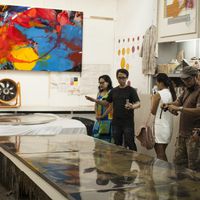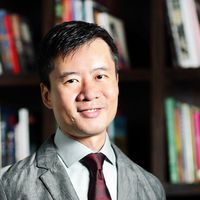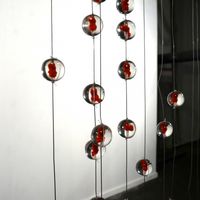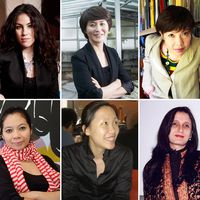Independent Curators Bridging Asia and Europe

Naima Morelli speaks with Loredana Paracciani, Katerina Valdivia Bruch and Valentina Levy, 3 curators who are bridging the European and the Asian art world through their independent practices.
In no library you will ever find a manual on how to be an international art critic and curator bridging the Eastern and Western world. In those pioneering professions fuelled by passion, there are no blueprints, no instructions to follow. Less so in the Asian art world, which is still far from having a solid steady network creating consistent exchange.
However, there is a group of curators who are individually working to create ties between East and West via art. The peculiar feature is that these curators are based in Europe - where they strengthen their connections with local institutions - and travel to Asia regularly to keep up with the scene.
This is the case with Loredana Paracciani, who is based in London and works extensively as an independent curator for commercial and institutional spaces in Singapore, Bangkok, London and New York. Born in Rome, after her majoring in Western art and cinema she was immediately drawn to a life of discovery, living in New York, Mexico, Paris and finally Bangkok, where she lived six years.
Her curatorial practice started in Singapore, where she lived 8 years. Today she encourages the visibility of young and emerging artists from Southeast Asia and her focus and research revolves around contemporary art in Thailand.
For Katerina Valdivia Bruch, a Berlin-based independent curator, arts writer and critic, the interest in Asian contemporary art started in Barcelona in 2005. At that time, she was working as Exhibitions Coordinator for Casa Asia, for which she got the chance to get in touch with some Asian contemporary artists.
Later, in 2008, she worked as press officer for the former Indian contemporary art gallery, BodhiBerlin, and got introduced to Indian contemporary art. The same year she went to Indonesia for the first time. Her interest on Indonesian art came through an artist friend, who did a residency in Yogyakarta and inspired her to start a curatorial residency at the artist collective MES56. Later, she travelled to Indonesia 3 more times, either for research purposes or to prepare exhibitions. Besides her work as a curator, she contributes essays and articles to art publications and magazines. Her research focus was on artists' initiatives, performativity in the visual arts, media and video arts, and censorship after 1998 (after Suharto's demise) in Indonesia.
The practice of art critic and curator Valentina Levy is focused on creating connections between the Asian continent, Italy, France and the African countries. Studying for her master degree in Asian Studies in Rome she felt in love with Japanese traditional art and architecture. However, when she started to work in her research project for her master degree around 2005, she could hardly find any books and documentation about contemporary art in Japan – not to mention works about other Asian countries. This encouraged her to start researching and building connections herself.
Pro and cons of being based in Europe

Loredana relocated to London in 2015. She sees the British capital as a good location to straddle the Western and Asian art scenes:
“I see great advantages of me being in London. To start with the incredible exposure to art at all levels, museums, galleries, talks, conferences, events of all types that are not even imaginable in Asia and that are able to widen one’s horizons incredibly. Also London is a much more central location. I can still travel to Asia, but I am also allowed many more opportunities in Asia.”
The disadvantage is of course being remote from her centre of interest. However, Loredana not only offsets this problem by travelling to Thailand or Southeast Asia on a regular basis, but also taking full advantage of the educational prime London can offer. Indeed, she recently enrolled in SOAS (School of Oriental and African Studies) of the University of London, one of the world's leading institutions in Asian and African studies. For Loredana, this became an important opportunity to further her research interests, which will inform her curatorial practice and vice versa:
“I do a lot of research anyways for my projects, but on my own. What I feel I need at this point is to be immersed in an academic context and be able to challenge ideas in a continued dialogue with like minded people.”
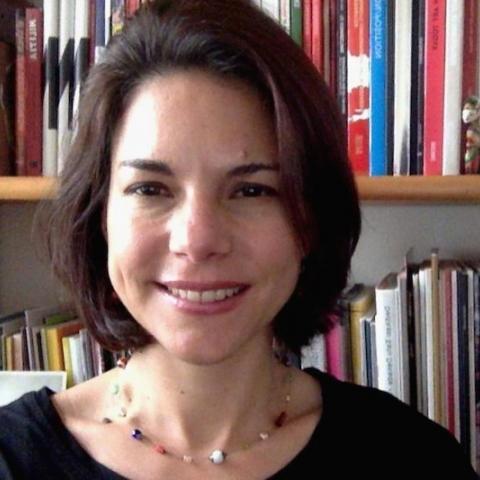
Katerina also has the chance to be immersed in the international art scene by living in the German capital city:
“You might find artists from anywhere in the world in Berlin. Some good artists from Asia live here. Another advantage is public funding for research and travel grants.”
If London and Berlin are contemporary art centres, Valentina doesn’t find Rome offering so many opportunities to people that want to start new initiatives in the art world. However, she has decided to live in the Eternal city for its beauty and vibrant cultural life:
“It is a city where everybody come at least once in a lifetime, and the art community is relatively small, so that is difficult to miss people when they are around. Strategically speaking, in my case, to be based in Rome is not a bad plan. In a couple of hours I can reach all the European capital cities, plus Rome is really in the heart of the Mediterranean sea, perfectly in between America and Asia, North Europe and North Africa.”
Travel schedules
To keep up with the Asian art scene, Valentina regularly organises two weeks or one month trips in which she schedules a number of studio visits and meetings with local artists, art dealers and curators. “As I can’t restlessly travel and work at the same time, I subscribed to the newsletter of the most relevant art galleries and I’m inscribed in the press mailing list of some of the best museums all over Asia, so that I can always keep an eye on their program wherever I am.”
Loredana travels back to Asia at least 4 times a year: “I can manage to stay longer in Asia in August and December, that is when my children are on holiday and I bring them with me. Otherwise, I schedule my trips according to my projects or research that I need to conduct. For each trip I try to fit as many meeting, studio visits as possible. My port of call is always Bangkok and form there I move on in Southeast Asia.”
Katerina’s curatorial focus has shifted a bit away from Indonesia, but she does follow the work of some artists she worked with in the past. She is still informing herself about what is currently happening in the Indonesian art scene: “In the last years, I have been curating less and writing more. Still, I continue publishing interviews with artists and curators from Indonesia. Also, some of my current publications mention topics related to Indonesian contemporary art, connecting them with other international art scenes.”
Connecting the local and the global
Valentina finds the rooting in the local art scene important in order to promote international projects, increase contacts and professional exchanges between East and West:
“I am working on several curatorial projects at the same time, and I’m deeply involved in the creation of an institute that will promote studies, research activities, conferences and workshops, international cultural projects and exhibitions between European, Asian and African countries. World Island Institute aims to create an AfroEurAsian network of artists, curators, writers, art professionals, galleries and institutions; a platform enhancing international cooperation and exchanges.”
Loredana also recognises the importance to be grounded in the local art world, and sees it as a pleasure and as a great learning opportunity. While she observed an increased interest towards Southeast Asia, she would like to see more of it: “I think part of it is due to lack of awareness and understanding of Southeast Asian cultures, and part is due to the fact that Southeast Asian art is very small in the art market.”
She has done some curatorial projects in London and recently collaborated in a show at Saatchi, but she found it still very challenging. “New York where I work also regularly, seems to be a much more of an interested interlocutor when it comes to Southeast Asia.” Currently she has a show at Sundaram Tagore Gallery in New York, titled “Heads or Tails? Uncertainties and Tensions in Contemporary Thailand”, featuring the works by six influential Thai artists examining divergent notions of present-day Thailand.
For Katerina it is mandatory to connect with the local arts scene first and read about the country's social and political situation to understand the context of the artworks: “Without this information, I cannot start working, as my practice has been mostly based on research, conferences and publications, and less on just exhibiting artworks.”
Katerina considers that since the late nineties there has been an increasing interest towards Asian contemporary art: “First it was China, then India, and for some years now it is Southeast Asia. For me, it is connected to the economy and not only to the art scene. I believe that you can find good art anywhere in the world. But, I think the art market is related to booming economies and that is how the focus on one or another country changes. It's just an assumption that I have, which I cannot prove, but I always thought that the sudden ‘boom’ or ‘interest’ was moved more by business opportunities in Asian countries, than the real interest in a particular art scene.”
Bios and links:
Loredana Pazzini Paracciani is an independent art curator, writer and lecturer of Southeast Asian contemporary art. She is based between London and Bangkok. Loredana works extensively with commercial spaces and art institutions in Singapore, Bangkok, London and New York to champion critical issues of Southeast Asian contemporary art and culture through the works of emerging and established artists from the region. Her curatorial practice is based on rigorous research and consistent dialogue with artists. Recent curated exhibitions include INTERLACE: Three Artists in the Cambodian Diaspora, in Cube Arts, New York, United States (2016); Asylum Seeker: The Pond and the Fireflies | A solo show by Prapat Jiwarangsan, The Jam Factory, Bangkok, Thailand (2016); REV|ACTION: Contemporary Art from Southeast Asia, Sundaram Tagore Gallery, New York, United States (2015); and Architectural Landscapes: SEA in the Forefront at the Queens Museum, Queens, New York, part of inToAsia Time-Based Art Festival (2015). Next year she will curate a big project at MAIIAM Contemporary art museum in Chiangmai Thailand focused on the tensions of diaspora in Southeast Asia - entangled within notions of home, transit, travel and displacement - and the act of crossing geopolitical borders. The show will open on March 3rd 2018.
https://theartling.com/en/artzine/2014/09/12/interview-loredana-pazzini-paracciani-curator-anthropos-new-york-exhibition/
Katerina Valdivia Bruch is a Berlin-based independent curator, writer and art critic. She studied Philosophy, Cultural Policies and Management and holds a M.A. in Museum Studies and Critical Theory of the Independent Study Programme, MACBA/Universitat Autònoma de Barcelona. Katerina has curated exhibitions and organised talks and lectures for a number of institutions, including ZKM-Center for Art and Media Karlsruhe, Bielefelder Kunstverein (Bielefeld), Grimmuseum (Berlin), CCCB (Barcelona), Instituto Cervantes (Berlin and Munich), Instituto Cultural de Leon (Mexico), Para Site Art Space (Hong Kong), and the Institute of Contemporary Arts Singapore, LASALLE College of the Arts. In 2008, she was co-curator of the Prague Triennale at the National Gallery in Prague. Besides her work as a curator, she contributes with essays and articles for art publications and magazines.
Valentina Gioia Levy is an art critic, curator and writer based in Rome. In 2007, she graduated in “Asian Studies” from the Rome University La Sapienza with a focus on Japanese Contemporary Art and in 2009 she graduated in Art Market Management from the E.A.C School in Paris. Currently she teaches History of Contemporary Art and Design at Accademia Italiana, in Rome. Since 2010, she collaborated with a number of museums and art galleries and cultural institutions all around the world, between which: the Pompidou Centre (Paris, France); MACRO, Museum of Contemporary Art of Rome (Rome, Italy); The Japan Foundation; the National Museum of Oriental Art (Rome, Italy); Palazzo Collicola Arti Visive (Civic Gallery of Modern Art of Spoleto, Italy); Label201 (Rome, Italy); MOG, Museum of Goa (Goa, India); Kochi Muziris Biennale (Kerala, India); the European Cultural Centre and Venice Biennale (Venice, Italy); DARB 1718 (Cairo, Egypt); OFF Biennale Cairo (Cairo, Egypt); Musée de l'IFAN, Institut Fondamental de l'Afrique Noire (Dakar, Senegal) among others. In 2011, with Elena Abbiatici, she founded the curatorial duo Abbiatici_Levy whose attention focuses on contemporary artistic practices that deal with audiovisual media culture and the sociology of the internet. In 2014, she coordinated a curatorial program for the National Museum of Oriental Art that aimed to present key Asian artists and practices. Since 2014 she has been the curator of the visual arts section of the Festival of Villa Ada in Rome. In 2016, she has been invited as guest curator to Dak'Art 12th Biennale of Contemporary African Art, under the direction of Simon Njami (Senegal, May 2016). She was also curator of LAM360, Land Art Mongolia Biennial and co-curator of the 5th Mediations Biennale (Poznan, Poland).
Similar content
25 Apr 2017
posted on
15 Aug 2011

